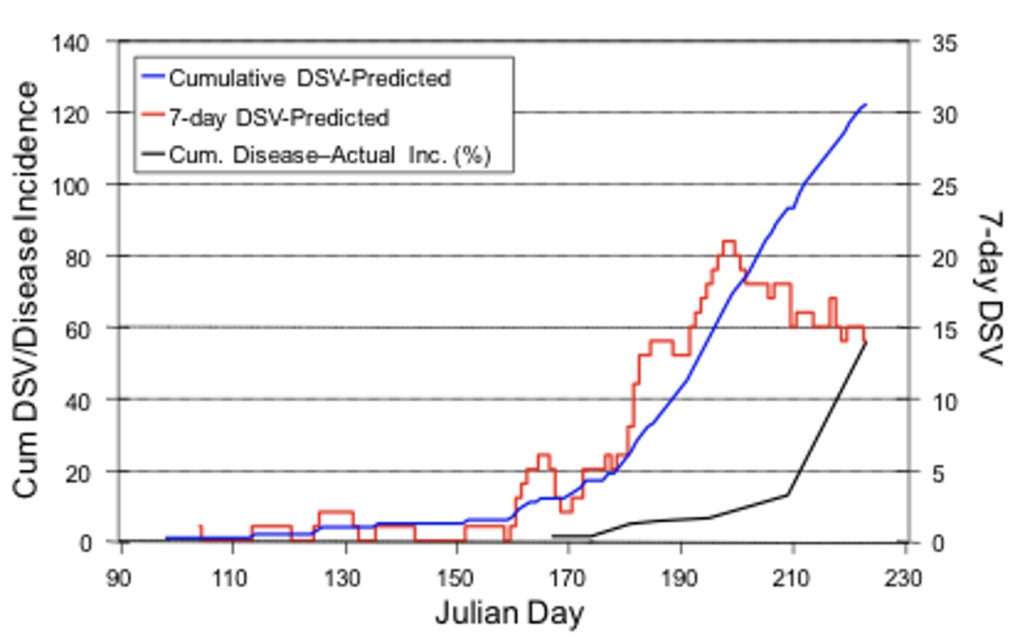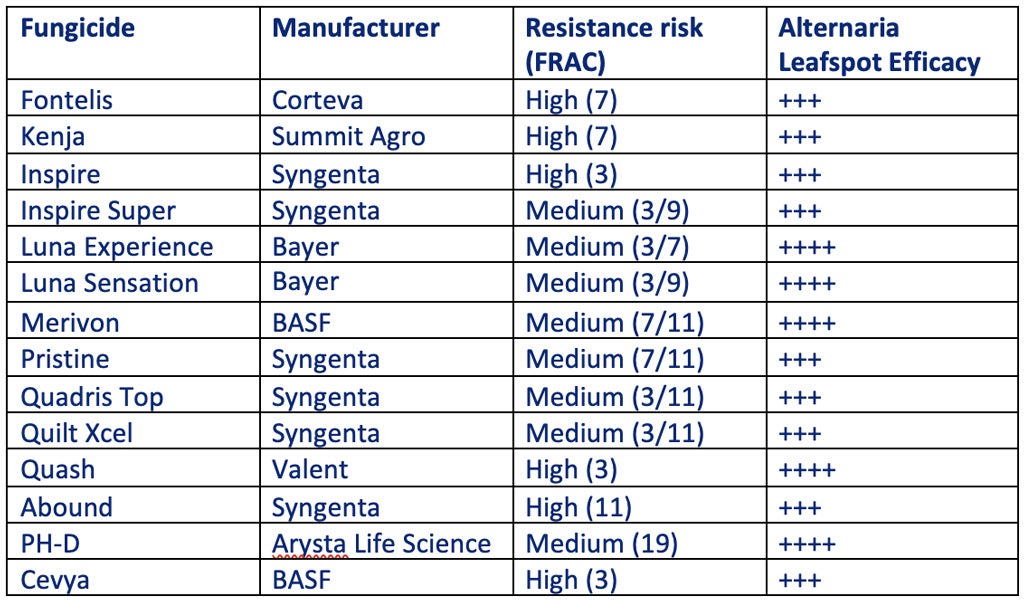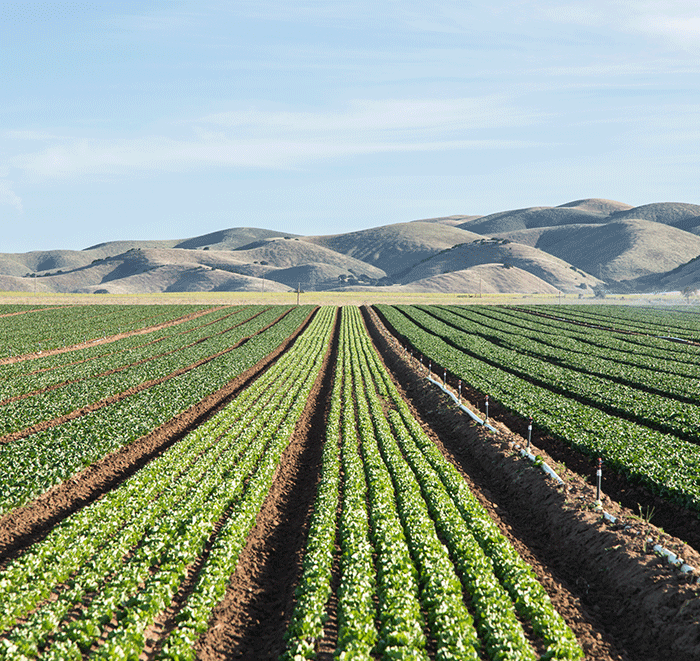
Signs, Symptoms, Location of Alternaria Throughout the Valley
Alternaria is a fungal disease that is caused by multiple species including A. alternata, A. arborescens, A. tennuissima. These forms of fungal species thrive in a high humidity- low airflow environment and can live on dead tissue or in the soil through resting spores, making it a non-obligate parasite. The lesions formed on the leaves tend to be in a circular shape, with a yellow hallo in the center. The circular shape tends to increase in size due to the inoculation that is yet to show. Alternaria is believed to be developing in orchards in late April through the summer months, but recent field observations have indicated that Alternaria is starting to develop and be present in mid-March, when most of the canopy is fully developed. The lesions that the Alternaria produces on leaves are also changing characteristics. They are no longer only circular shape lesions with a yellow halo, they are irregular shaped and can occupy 70% of an infected leaf, but the irregular shape lesions continue to have the halo surrounding it when the process of infection is present. Symptoms of Alternaria are showing up in areas of the valley where it was normally not a problem. For example, in the west side of Fresno, Alternaria has been showing up increasingly in recent years. Juan Rosales, a PCA, CCA and Sales Manager believes that a reason we are seeing an increase of Alternaria in areas where it was not common is because of a monocrop culture that has been created with almonds. Although fungicides can be effective when controlling Alternaria, there are other practices that the grower should consider besides fungicide application.
IPM Practices That Help Manage Alternaria Leaf Spot
- Alternaria Leaf Spot will present itself first and is often the most severe on exposed tissues.
- Environmental conditions that can increase pressure/severity include high humidity, heavy dew, and poor air flow. Practices that aid in improving these conditions include:
- Selective pruning to increase ventilation
- Planting orchards with rows oriented parallel to prevailing winds to increase air flow
- Replacing flood irrigation systems with drip/sprinkler systems to decrease dew/humidity
- Applications of AQUATE® MAX, which contains both hydration and infiltration surfactants to increase water penetration and soil retention, to decrease overall humidity
- Trees that have been trained with a spreading and open canopy tend to have higher disease pressure.
- Intensive scouting before Alternaria Leaf Spot is present in the field is crucial to correctly timing fungicide applications.
- Begin monitoring for symptoms of the disease in early-April through June, if symptoms are present begin treatments around mid-April
- In orchards with history of high disease pressure, treat around mid-April and again 2-3 weeks post-treatment
- The varieties Carmel, Monterey, Butte, Sonora, and Winters are most susceptible.
Alternaria Leafspot Treatment Timing
Note: Not all indicated timings may be necessary for disease control.

Spring applications of two and five weeks after petal fall are general timings to represent early post-bloom and the latest time that most fungicides can be applied. The exact timing is not critical but depends on the occurrence of rainfall. Alternaria appears to be most severe where dew forms, humidity is high, and air is stagnant. Spring rainfall and rising temperatures should be considered for spring application timing. For Alternaria, a disease severity value or DSV model has been developed on tomato and modified for almond for forecasting Alternaria leaf spot. Index values are assigned for specific ranges of average temperatures during leaf wetness periods during a day. Apply fungicides if accumulated index values over a 7-day period reach a value of 10 or higher.


Field Micro-climate- Probe/Weather Station Opportunity
Alternaria is often referred to as a high production disease. As Alternaria is often more severe in orchards with less air movement, heavy dew, and high humidity. Factors that can affect air movement and humidity include: tree training, pruning, irrigation and how the orchard is planted in relation to North-South or East-West. All these factors are individual to each field, which means each field is a micro-climate, that can be affected by Alternaria differently within a geographical area. Using a disease severity value or DSV model for Alternaria is most useful when using weather data accumulated in a specific orchard. Wilbur-Ellis acquired Probe Schedule LLC to provide its customers with one of the most technologically innovative irrigation water management systems in the world.
Probe Schedule is a leading irrigation management company backed by 24 years of continual research and development efforts. Its irrigation water management (IWM) software receives and collects data from in-field hardware devices and weather stations to calculate accurate crop water usage and soil moisture, providing growers with specialized irrigation schedules. With Probe Schedule now part of its customer offer, Wilbur-Ellis brings quality IWM field data directly to growers, adding value to their operation, helping to improve productivity and positively benefiting their business. This in-field weather station tracking and probe data can help model for Alternaria leafspot at the field level. Helping predict leaf moisture and humidity at a micro-climate field level. This data and disease forecasting can allow for better fungicide timing.
Alternaria Leafspot Fungicide Efficacy

Rating: ++++ = excellent and Consistent, +++ = good and reliable, ++ = moderate and variable, + = limited and/or erratic, +/- = minimal and often ineffective, —- = ineffective, NL = not on label, and ND = no data. Only Products listed as +++ and ++++ for Alternaria leaf spot are included on this chart. Fungicide Efficacy ratings based on UC IPM “Fungicide Efficacy for Almond” https://www2.ipm.ucanr.edu/agriculture/almond/Fungicide-Efficacy-for-Almonds-Diseases/
Chemical Rotation
Code numbers are assigned by the Fungicide Resistance ACTION Committee (FRAC) according to different modes of actions. Fungicides with a different code number (FRAC) are suitable to alternate in a resistance management program. In California, make no more than one application of fungicides with mode-of-actions (MOA) with high resistance risk before rotating to a fungicide with a different MOA (Code number); for other fungicides, make no more than two consecutive applications before rotating to fungicides with a different MOA (Code number). There has been reported Alternaria sp. Resistance to strobilurins and dehydrogenase inhibitor (SDHI) fungicides has been reported in some orchards throughout California. FRAC groups 7 and 11 should not be used in these orchards with documented resistance.
Jeremiah Lucas, Wilbur-Ellis Sale Representative

